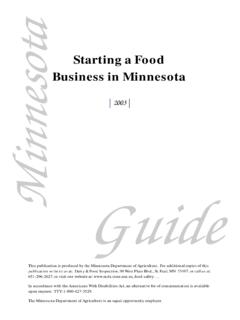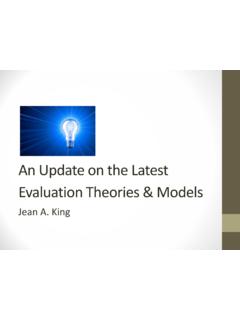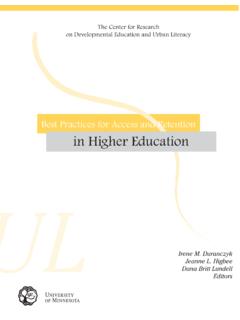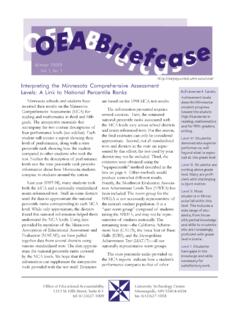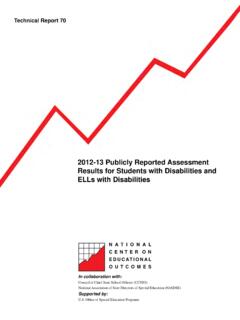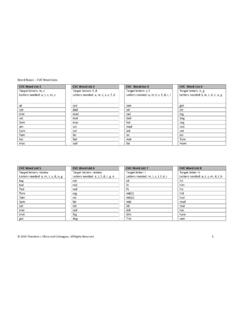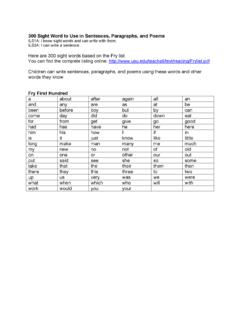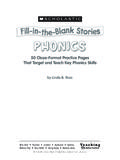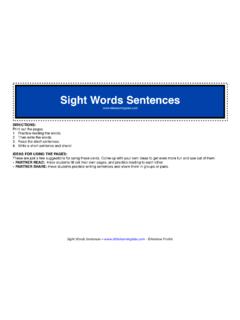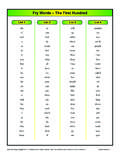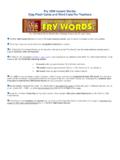Transcription of Intervention Guide: Sight Word Flashcards (Kindergarten)
1 2016 Theodore J. Christ and Colleagues All Rights Reserved. 1 Intervention guide : Sight Word Flashcards ( kindergarten ) Purpose Objective: Students will master 50 Sight words using an incremental rehearsal (IR) flashcard approach. Skill Area/Need: Accuracy of the 50 Sight words . Preparation Pre-assessment Determine what Sight words to teach by reviewing Sight word inventory list (FAST earlyReading assessments, Sight words ) to identify all of the unknown words and known words for the group in general or individual student. o Consider using the Group Skills Report for Sight words o If the inventory option was not used during screening, complete the inventory with students needing Intervention . Progress Monitoring earlyReading Sight words ( kindergarten ) Time Conduct Intervention 3-5 times per week for 5-10 minutes until 50 Sight words are mastered (approximately 5-8 weeks) o The goal is to learn 3-10 words per week Materials 1-2 unknown Sight word flash cards and 5 known Sight word flash cards for teacher Prepared phrases/short sentences that go along with Sight word cards o Option: write/print phrases on sentence strips kindergarten 50 Sight Word Lesson Log Format Large group, small group or one-on-one with teacher leading Intervention o May modify Intervention in large group to include peer partnering (include enough student flashcard sets when preparing materials).
2 Daily Lesson Plan Introduce 1-2 new unknown words each day. The following day, review unknown words from previous day(s) until the unknown words become known words . o An unknown words becomes a known word when it has been read correctly within 2 seconds during at least 3 different sessions. 2016 Theodore J. Christ and Colleagues All Rights Reserved. 2 Intervention Procedures Prepare Materials 1. Identify 1-2 unknown Sight words and 5 known Sight words the student(s) need to practice from the master deck of 50 Sight word cards. The words can be selected by reviewing the FAST Group Skills Report for Sight words . Then, select one unknown Sight word and place it on the top of the pile of the 5 known Sight word cards. Example includes: 2 unknowns: was, you; 5 knowns: I, a, if, it, in 2.
3 Prepare 1-2 short phrases or sentences with the unknown Sight words in the sentences . Use a book or story from core instruction with the unknown words in it if possible. Use sentence strips with the 1-2 short phrases or sentences . Explain the Activity 3. Explain the activity by providing the basic objective and what the activity includes (this step can be shortened when students become familiar with the Intervention activity). Today you will learn the words was and you . These words are important to learn because the words are many sentences in books. We will be practicing these Sight words by going through a flashcard activity and then reading sentences with the Sight words in them Review Sight words 4. Show the student(s) the first card with the first unknown word, was, at the top of the pile.
4 Read it for the student(s) and have the student(s) say the word after you (chorally or one-by-one). Then read through all of the words in the deck with the students repeating after you to make sure the students can say all of the words correctly. Say: First we will go through the deck of words and I will say the word and then you will repeat the word after me all together. o This word is was. What word? (Student response). Good, this word is was. Model the Activity and Provide Guided Practice 5. Next, show the student(s) the first word again, was, and have the student(s) read it. Say: Now we will do the flashcard activity together. What word? (Student response). Good, this word is was. (prompt response if needed until students provide responses within 3 seconds or less). 6. Then, show the first known word, I , and have student(s) read it without modeling word.
5 What word? (Student response). Good, this word is I. 7. Go back to the beginning and show was again and have student(s) read it. Then show the known word I and then the known word a. The pattern is to show the unknown word and then all of the previously shown known words adding one additional known word in a growing pattern: was - I 2016 Theodore J. Christ and Colleagues All Rights Reserved. 3 was - I - a was - I - a - if was - I - a - if - it was - I - a - if - it - in 8. After completing the flashcard sequence with the first unknown word, confirm that all students know the word by having each student take a turn reading the unknown word. Then, this becomes a known card in the next sequence with the other knowns in the deck. Now I want each of you to take a turn reading the word to me.
6 Provide corrective feedback if needed and note which students have not yet mastered the word (if any). 9. Next, the second unknown word, you is presented. Read the word to the students and then have the students read it. This word is you. What word? (Student response). Good, this word is you. 10. Then, repeat the flashcard sequence activity with the second unknown: you you - was you - was - I you - was - I - a you - was - I - a - if you - was - I - a - if - it you - was - I - a - if - it - in 11. After completing the flashcard sequence, confirm that the students know all of the words by mixing up the deck and having each student read the words individually. See Step 8. If desired, the students can track the words they have learned on a class-wide tracking chart on a wall or board.
7 Give Clear Feedback 12. Provide verbal praise after each correctly read word throughout the activity. As student responses become automatic, level of verbal praise can be reduced ( , provide a head nod to acknowledge correct responses versus verbal response). 13. Provide corrective feedback when any student makes a mistake on any card or if students do not respond within 3 seconds of showing the card. With a neutral tone, read the word correctly and have all students repeat it before moving onto the next card. (No), this word is was . What s this word? (student response). Good. Provide Applied Practice 14. After learning the words , provide time for students to read the words in the prepared short phrase/ sentences or other connected text/book with the words in it. Model the phrases/ sentences first, read it with the students all together, and then have the students read them chorally or pair and share.
8 The sentences or phrases can be written on sentence strips, the marker board or typed and displayed on a smartboard. 2016 Theodore J. Christ and Colleagues All Rights Reserved. 4 Additional Ideas Procedure Modifications or Accommodations When first beginning to teach Sight words to kindergarten students, consider spending time going over the features of the word. For example, say the sound it starts with, the number of letters in the word. Then, have students spell the word with you while pointing to each letter and then have the students write the word in the air. If students have difficulty responding in unison, teach the students how to respond together by practicing what it sounds like to respond chorally and then move on to the Sight word flashcard sequences. Teacher may also opt to use a smartboard for the flashcard sequence by creating the sequences of Flashcards in a powerpoint slideshow prior to implementation For larger groups, consider teaching the general strategy to all students the first 2-3 days and then provide Flashcards for sets of partners who can complete the flashcard activity in pairs.
9 Then, have the pairs of students read sentences together or as a group. The ratio of unknown to knowns can be changed to match the needs of your students. For kindergarten students, 1-2 unknowns and 5 knowns was chosen but 3 knowns and 9 unknowns (to match most typical IR ratio of 1:9) can be used. Write the unknown words for the day (and week) on the board and provide opportunities for students to practice the words throughout the week. o Review words together as a class at the end of each day. Have students use each of the words in a phrase or sentence of their own and have the students write down the sentence(s) if possible with the word(s) they used underlined.
